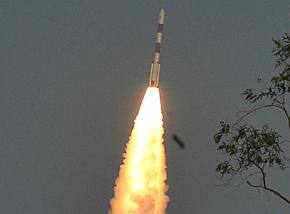India gets its own space observatory, joins select group

India joined a select group of nations owning space observatory with the successful launch of ASTROSAT by its rocket on Monday, which also put into orbit six other foreign satellites.
With the successful launch of ASTROSAT, India gained an entry into the select club of nations having its own space observatory after the US, Japan, Russia and Europe.
Exactly at 10 a.m. (IST) the 44.4 metres tall weighing around 320 ton polar satellite launch vehicle's XL variant (PSLV-XL) blasted off the first launch pad at the rocket port in Sriharikota, around 80 km from Chennai, India.
The PSLV-XL rocket with seven satellites cumulatively weighing 1,631 kg climbed up steadily gathering speed amidst the cheers of Indian space agency officials and the media team assembled in Sriharikota.
The expendable rocket carried Rs.180 crore ASTROSAT, India's first dedicated multi-wavelength space observatory that will help in understanding the universe, and six other foreign satellites.
While ASTROSAT with a five year life span weighed 1,513 kg, the six foreign satellites (four from the US and one each from Indonesia and Canada) together weighed 118 kg.
Incidentally, this is the first time that an Indian rocket launched satellites from the US.
For the third time a PSLV rocket has launched seven satellites in a single mission. In 2008, ISRO had launched 10 satellites in one go, including India's Cartosate-2A satellite.
Till date, India has launched 45 foreign satellites for a fee.
However, it will not be right to call ASTROSAT as India's 'Hubble'. The Hubble owned and launched by the US in 1990 is 10 times heavier than the ASTROSAT and is said to cost $2.5 billion.
While the Hubble space telescope is still working now, India's ASTROSAT's life span is five years.
ASTROSAT, will observe the universe through optical, ultraviolet, low and high energy X-ray components of the electromagnetic spectrum, whereas most other scientific satellites are capable of observing through a narrow wavelength band.
India joined a select group of nations owning space observatory with the successful launch of ASTROSAT by its rocket on Monday, which also put into orbit six other foreign satellites.
With the successful launch of ASTROSAT, India gained an entry into the select club of nations having its own...
India joined a select group of nations owning space observatory with the successful launch of ASTROSAT by its rocket on Monday, which also put into orbit six other foreign satellites.
With the successful launch of ASTROSAT, India gained an entry into the select club of nations having its own space observatory after the US, Japan, Russia and Europe.
Exactly at 10 a.m. (IST) the 44.4 metres tall weighing around 320 ton polar satellite launch vehicle's XL variant (PSLV-XL) blasted off the first launch pad at the rocket port in Sriharikota, around 80 km from Chennai, India.
The PSLV-XL rocket with seven satellites cumulatively weighing 1,631 kg climbed up steadily gathering speed amidst the cheers of Indian space agency officials and the media team assembled in Sriharikota.
The expendable rocket carried Rs.180 crore ASTROSAT, India's first dedicated multi-wavelength space observatory that will help in understanding the universe, and six other foreign satellites.
While ASTROSAT with a five year life span weighed 1,513 kg, the six foreign satellites (four from the US and one each from Indonesia and Canada) together weighed 118 kg.
Incidentally, this is the first time that an Indian rocket launched satellites from the US.
For the third time a PSLV rocket has launched seven satellites in a single mission. In 2008, ISRO had launched 10 satellites in one go, including India's Cartosate-2A satellite.
Till date, India has launched 45 foreign satellites for a fee.
However, it will not be right to call ASTROSAT as India's 'Hubble'. The Hubble owned and launched by the US in 1990 is 10 times heavier than the ASTROSAT and is said to cost $2.5 billion.
While the Hubble space telescope is still working now, India's ASTROSAT's life span is five years.
ASTROSAT, will observe the universe through optical, ultraviolet, low and high energy X-ray components of the electromagnetic spectrum, whereas most other scientific satellites are capable of observing through a narrow wavelength band.









Leave a Comment